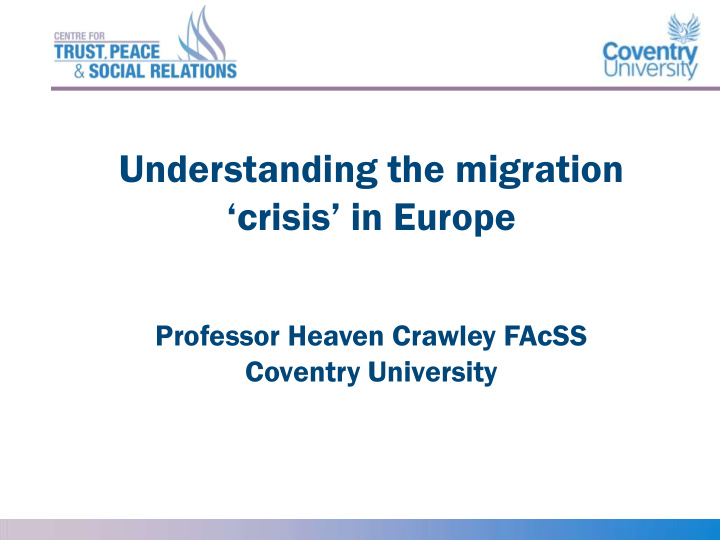



Understanding the migration ‘crisis’ in Europe Professor Heaven Crawley FAcSS Coventry University
Migration in Europe o According to the International Organisation for Migration (IOM), 773,274 migrants are entered Europe in 2015, but exact numbers are unclear o Numbers increased in October 2015 when 210,000 arrived by sea (increase of 3,000% on October 2014) o Although not all migrants claim asylum over half a million have done so, according to the EU statistics agency Eurostat o Germany continues to be the most popular destination for migrants arriving in Europe and has received the highest number of new asylum applications, with almost 222,000 by the end of August (but shift to ‘subsidiary protection’) o Large number of people now in transit through the Balkans o Hungary has moved into second place, as more migrants have tried to make the journey overland through Greece and the Western Balkans, 96,350 applications by the end of July • 3,423 migrants dead/missing in the Mediterranean (most likely an underestimate)
Causes of the ‘crisis’ o Conflict is single biggest reason for increased migration to Europe o 85% come from world’s top -ten refugee producing countries (93% of those arriving in Greece) o The lives of these migrants are characterised by experiences of war, conflict and persecution esp. Syria, Eritrea, Somalia, Afghanistan o Others migrate due to inability to make a livelihood, for example from countries of West and Central Africa, Bangladesh, Pakistan o Important to understand the continuum between ‘economic’ and ‘forced’ migration those who leave their country or origin may find themselves in refugee-like situations esp. in Libya o Important to recognise that forced migrants, like all migrants, do make some choices, albeit within a narrower range of possibilities, but may then be viewed as economic migrants e.g. Syrians o Important to remember that vast majority of world’s refugees (more than 95%) remain in countries and regions of origin
A migration crisis or a crisis of solidarity? o Arrival of migrants and refugees has brought with it serious challenges to the idea of a Common Asylum System and free movement within EU o Lack of safe and legal opportunities to enter the EU for protection or work associated with large scale irregular migration and effective collapse of external and border internal controls including suspension of ‘Dublin Regulation’ o Cascading border closures, beginning with Hungary closing its border with Serbia on September 15 th and then border with Croatia on October 16 th , has contributed to humanitarian crisis o Lack of EU / international support for Greek islands where around 7,000 – 9,000 people arrived every day in October (increased deaths) o Failure to establish a credible-system system for responsibility-sharing across the EU through the relocation of asylum seekers (40,000 places 160,000 but just 854 in practice and 112 relocated) o Valetta Migration Submit aims to provide long terms ‘solutions’ to increased migration but concern that focus will be on border controls and readmission agreements rather than creating safe passage or addressing root causes
For or fu further ther in infor ormat mation ion Email: heaven.crawley@coventry.ac.uk Twitter: @heavencrawley Facebook Group: Migration, Displacement and Belonging Tel: +44 (0)7813 127121
Recommend
More recommend